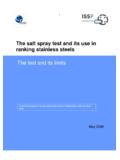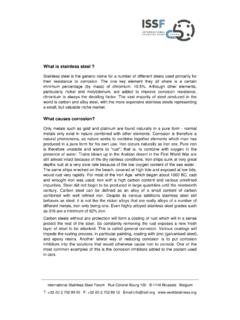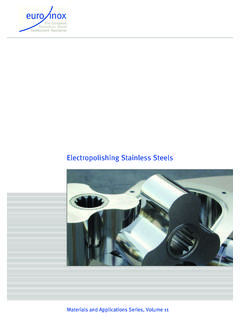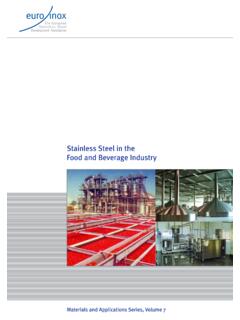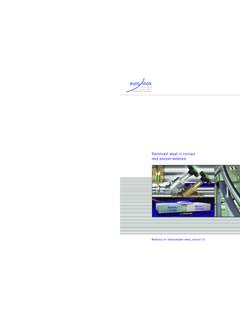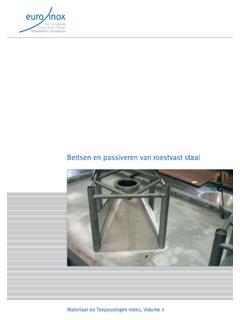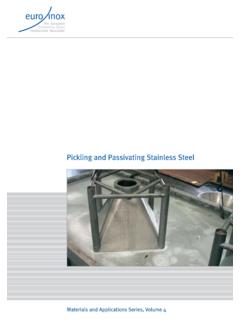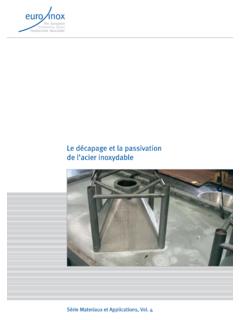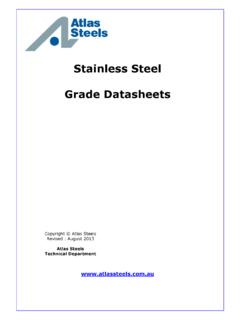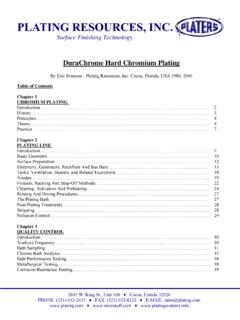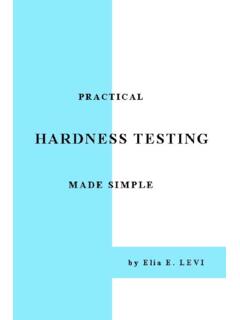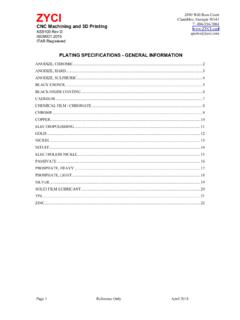Transcription of Surface Hardening of Stainless Steels
1 Materials and Applications Series, Volume 20 Surface Hardening of Stainless SteelsEuro InoxEuro Inox is the European market development asso-ciation for Stainless steel. Members of Euro Inox include: European Stainless steel producers; national Stainless steel development associations; development associations of the alloying element prime objectives of Euro Inox are to create aware-ness of the unique properties of Stainless steel and to further its use in existing applications and in new markets. To achieve these objectives, Euro Inox organises conferences and seminars and issues guid-ance in printed and electronic form, to enable archi-tects, designers, specifiers, fabricators and end users to become more familiar with the material.
2 Euro Inox also supports technical and market research. ISBN 978-2-87997-395-1 Full Stainless Steel Association (BSSA) Edelstahl Chromium Development Association (ICDA) Molybdenum Association (IMOA) Nickel Institute Paslanmaz elik Derne i (PASDER) Stal Hardening OF Stainless STEELSS urface Hardening of Stainless SteelsSecond edition 2015(Materials and Applications Series, Volume 20) Euro Inox 2013-2015 PublisherEuro InoxAvenue des Cerisiers 15, bte. 11030 BrusselsPhone +32 486 50 37 53E-mail: Kosma , Brussels (B)Cover photosExpanite, Hiller d (DK) (left)iStockphoto (top right)Bodycote Hardiff, D sseldorf (D) (bottom right)Copyright noticeThis work is subject to copyright.
3 Euro Inox reserves all rights of translation in any language, reprinting, re-use of illustrations, recitation and broadcasting. No part of this publication may be reproduced, stored in a retrieval system or transmitted in any form or by any means, electronic, mechanical, photocopying, recording or otherwise, without the prior written per-mission of the copyright owner, Euro Inox. Violations may be subject to legal proceedings, involving mon-etary damages as well as compensation for costs and legal fees, under Luxembourg copyright law and regulations within the European Introduction 22 Principle 33 Thermochemical diffusion methods Carburising Gas nitriding Plasma (ion)
4 Nitriding and liquid nitriding Nitrocarburising Boriding or boronising 134 Applied energy methods Induction Hardening 145 Costs 156 Summary 167 References 17 DisclaimerEuro Inox has made every effort to ensure that the information presented in this document is techni-cally correct. However, the reader is advised that the material contained herein is for general information purposes only. Euro Inox and its members, specifically disclaim any liability or responsibility for loss, dam-age or injury, resulting from the use of the informationcontained in this Hardening OF Stainless STEELS2 Stainless steel is widely used in applications in which corrosion resistance is of high im-portance.
5 In many end-uses, the material is also expected to have a hard , scratch-resist-ant Surface . When improved wear resistance is required, Surface engineering provides solutions. Industrially proven processes are available that improve Surface hardness, scratch and wear most often expected from sur-face Hardening [1, 2]: scratch resistance Surface hardness above 900 unchanged corrosion resistance reduced friction coefficient no dimensional change minimal or no change in visual appearance no cracking or flaking of the hardened layer minimal or no change in Surface roughness no pre-treatment no post-treatment enhanced lifetime and reduced downtime and costs weldability suppression of fretting/galling (adhesion)
6 Surface Hardening provides surfaces for different consumer products and ensures that Stainless home appliances, household objects, cutlery and highly exposed objects maintain their pleasing appearance and durability. It is also necessary in industrial applications where exceptional wear resist-ance combined with corrosion resistance are needed. A wide range of such applica-tions can be found in [1, 2, 3, 4, 5]: consumer goods household appliances food and beverage industry mobile devices industrial fluid handling industrial and consumer fasteners valve and pump parts medical applications marine applications automotive components axis and rotating parts 1 IntroductionSURFACE Hardening OF Stainless STEELSS cratch resistance of the Surface is often requested for high-visibility Hardening can be used in many differ-ent areas, from building and architecture to the food and beverage industry.
7 Photo: Heat & Surface Treatment, Eindhoven (NL)3 Surface Hardening includes a wide variety of techniques. Most often it is used to im-prove the wear resistance of parts without affecting the softer, tough base material necessary to resist impact occurring during operation. Wear involves the physical removal of material from a solid object. It can be divided into three categories: abrasive, adhesive and fatigue wear. Abrasive wear is when two surfaces rub together and the harder Surface grinds away the softer. It can be characterized by a rough appearance.
8 Often, work Hardening of the Surface can occur. Adhesive wear, like abrasive wear, is caused by loaded surfaces rubbing to-gether. With adhesive wear, high local-ized temperatures are created by friction at the tips of opposing asperities on rub-bing surfaces. These tips can deform and weld together, due to localized temper-atures. They either break and fall away as debris or are cold-welded wear occurs whenever a Surface is subjected to repeated high-stress load. Wear rates are less affected by tem-perature than is corrosion [6].There are three distinctly different ap-proaches to the various Surface - Hardening methods [7]:1.
9 Thermochemical diffusion methods, which modify the chemical composition of the Surface with Hardening species such as carbon, nitrogen and boron. Dif-fusion methods allow effective Hardening of the entire Surface . They can be used for both single parts and batches. 2. Applied energy or thermal methods, which do not modify the chemical com-position of the Surface but rather improve properties by altering the Surface struc-ture that is they produce a quench- hard -ened Surface , without additional alloying species. They can be used to harden the entire Surface or only part of it (selective Surface - Hardening ).
10 3. Surface coating or Surface -modification methods, which involve the intentional build-up of a new layer on the steel process methods for the Surface Hardening of Steels are shown in Table 1. These long-established techniques are continually improved and remain among the most widely applied ones. This publica-tion discusses the most important Surface - Hardening methods used on Stainless Steels (marked in italics in the following table).2 PrincipleSURFACE Hardening OF Stainless STEELS4 Table 1. Process methods for the Surface Hardening of Steels [7]
